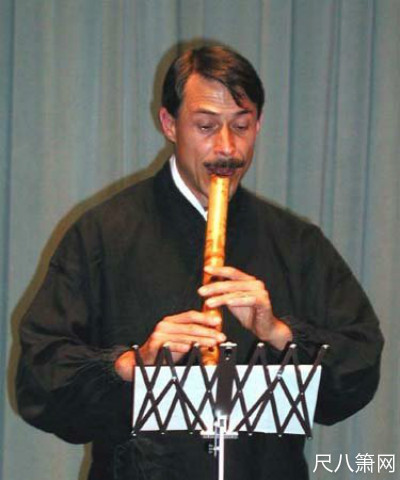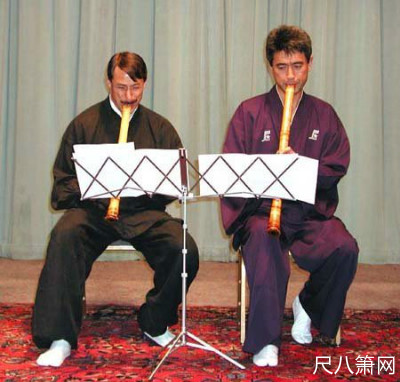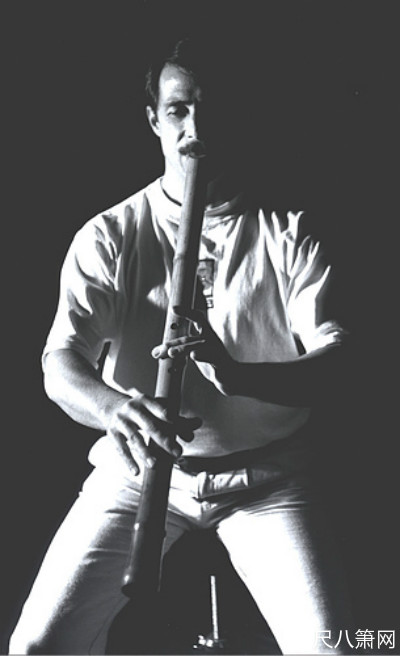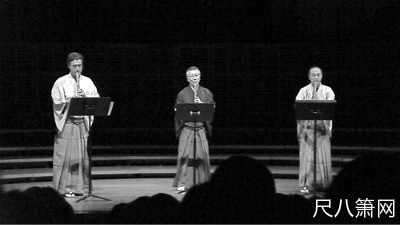尺八演奏家 – Dr. Riley Lee 博士
学尺八的老外太多了,目前非日本人,却能在尺八领域极具知名度的”外国人”,常听到的有 John Neptune (海山), Blasdel, Christopher Yohmei (遥盟), 还有Dr. Riley Lee.,以个人了解,以上述三位较具知名度.

今天介绍的是 Dr. Riley Lee., 原因: 具1/2华人血统. 国内可以买到他的几片CD,希望陆续可以将其文章- YEARNING FOR THE BELL: A STUDY OF TRANSMISSION
IN THE SHAKUHACHI HONKYOKU TRADITION中,对大家有帮助的部份翻译出来.
以下这篇为其网站中的自我介绍,并未100%照翻,有些部份就省略了,如果你(你)有兴趣,建议进入其网站慢慢浏览,应有所获.
http://www.rileylee.net/
http://www.komuso.com/people/Lee,_Dr_Riley_Kelly.html
Riley Lee的尺八学习之旅
与尺八的初遇
Riley 第一次听到尺八的声音是在1967年,从他的哥哥带回来的一张唱片上听到尺八的声音,后来他的华人父亲买了一支洞箫给他,也教他吹了一首中国地方名谣.
1971年,他2度踏上日本自助旅行兼旅游,花光盘缠,决定打工三个月赚取回夏威夷的机票,突然想起他父亲给它他的中国洞箫,于是前往大坂的坂急百货店,一看之下, 价格从日币10,000.到50000都有, 对他而言就是看起来没差异的竹子,于是问店员差异在那裡,虽然店员本身也吹尺八,但怕解释不清的情况下,告诉他要知道其中的差异, 最好找个老师瞭解,于是翻了电话簿,帮他找了一位他觉得是最好的尺八老师,并为Riley安排了一堂尺八课程,这一堂课,从此让Riley踏上了尺八学习之路,这一堂课, 也让Riley停留了7年之久.
由一位老人家的介绍开始学习尺八,到购买尺八,从三个月逗留在日本,到展开了七年的学习之旅,到现在以尺八为生活中心与重心。
Note: (这间百货公司现在还存在,百货公司内的乐器店还摆著6~7支尺八,打工的学生也会吹尺八,店裡也卖许多的尺八乐谱.2005年看到的尺八是製管师井上昌山的作品,价格约120,000. ~ 200,000.日币.)
Dr. Riley Lee 1971 年在日本最早是都山流 星田一山二世门下学生 , 8个月后有感都山流并无所谓古典本曲,经友人介绍引见,改向竹保流二世酒井竹保学习古典本曲, 1980年取得竹保流二世酒井竹保授予大师范证书,向二世酒井竹保的尺八学习一直延续到酒井竹保生病无法教导学生为止,时间大约是1980年初, 1984年开始向横山胜也学习尺八直到现在。竹保流 http://www.chikuhoryu.jp/
Dr. Riley Lee 1951年在美国德州赖利出生, 1957 年搬到奥克拉荷马州, 13岁那年加入乐团成为bass player。1966 年他和他的家庭搬到夏威夷。1970年他第一次去日本, 1971年再度回到日本,开始了他的尺八学习研究之旅。他连续在日本居住直到1977 年。
从1973年开始, Dr. Riley Lee加入日本的太鼓团体巡迴世界各地演出,负责尺八与笛的演奏部份,在许多著名地点表演过,如波士顿交响乐团,如华盛顿特区甘迺迪中心, 伦敦圆形剧院, 巴黎Espace Pierre Cardin。
Dr. Riley Lee的训练方式与传统太鼓乐团一样,如赤足在雪上跑步, 瀑布之下吹笛,在飞雪,冰柱环境下练习,并且跑波士顿马拉松后, 然后接著在终点线演奏太鼓。(u有点像鬼太鼓的训练方式.
1976年,在欧洲游览中与Ondekoza, 赖利遇见了(派翠西亚)Patricia, 她当时住在巴黎。后来Patricia 与Riley Lee回到了太鼓团体训练所在地佐渡岛, 1977 年离开太鼓团体并于同年结婚。Patricia 自1992 年以来,一直是Riley Lee主要的经理人/经纪人。
在返回到夏威夷-檀香山以后,于1978年他开始教尺八。他创办了夏威夷尺八团体(学校)。从1978 - 1986 年, 他一直是夏威夷大学的讲师, 一直到1986年前往澳洲雪梨大学攻读博士学位为为止。
Dr. Riley Lee在夏威夷大学完成了他的音乐学士与硕士学位,在雪梨大学取得音乐学博士学位。他的博士论文题目是 - 尺八与禅宗的关系。
1993他的PhD 学术论文由美国UMI 出版 <尺八与禅宗的关系>。
,Riley有系统的将日本音乐介绍到澳洲,以独奏方式,或与其他乐器合作,如竖琴、大提琴、萨克斯管、印度手鼓(tabla)、吉他、澳洲土著吹管乐器(didjeridu), 也和交响乐乐队合作演奏尺八。1996 年他协助成立Australian Shakuhachi Society (豪州尺八会)。1988 年,在他的请求之下,日本的十三弦琴学校派了一位十三弦琴演奏家Satsuki Odamura到澳洲,后来也促成其移民到澳洲,并以教授与演奏为生。

Satsuki Odamur网页 http://satsukikoto.com.au/satsuki/index.html
1995 年, 他与Ian Cleworth共同创办与澳洲的太鼓团体--TaikOz 。它后来成为的澳洲主要表演团体。1999年与雪梨舞蹈团体合作, , 2000年后期在美国,2001年在欧洲表演。
1980年至今,已出版过50几片CD,唱片,全世界贩售。
在2000 年1月1 日新年的黎明,Riley其它五位音乐家在雪梨歌剧院 表演,并在电视上转播,迎接另一个一千年的到来。
2002 年和2003 年, Riley在世界各地演奏-在夏威夷、新墨西哥、德州、加州、英国、奥地利、瑞士和日本, 在澳洲举行许多场次的音乐会, 并且在Woodford and National Folk Festivals, Adelaide Festival, Sacred Music Festival in Brisbane.等音乐节日演奏。
2003 年, 他成为美国纽泽西州普林斯顿大学的访问学者。
Riley目前与他的妻子Patricia 居住在澳洲。
1980, Riley接受了一位从事针灸医生学生Ross Penman的建议,开始教导人们 “呼吸的训练”。Riley后来又将课程提升并扩展课程内容。这个课程的目地在于藉由呼吸达到控制呼吸,并强化肌肉的力量。课程从一个到六个小时, 到目前已有超过2000人参加过。在他的DVD中,Riley也教导学生呼吸的方法。

Riley的官方网站 http://www.rileylee.net/
Riley's Journey
RILEY LEE began playing the shakuhachi (bamboo flute) in Japan in 1971, studying with Chikuho Sakai until 1980, and has been a student of Katsuya Yokoyama since 1984. He was given the rank of Dai Shihan (grand master) in 1980.
Riley was born in Plainview Texas USA in 1951, and moved to Shawnee Oklahoma USA in 1957, where, aged 13, he became the bass player of the award winning rock band "The Workouts". He and his family moved to Hawai'i in 1966. He first went to Japan in 1970, and returned in 1971, when he began his shakuhachi studies. He lived there continuously until 1977.
From 1973, Riley toured internationally as a full-time performer of taiko (Japanese festival drums), yokobue (a high pitched bamboo transverse flute) and shakuhachi with Ondekoza (now called Kodo) a troupe of traditional Japanese musicians, performing with such groups as the Boston Symphony Orchestra, and at venues such as Kennedy Center (Washington DC), Roundhouse Theatre (London), Espace Pierre Cardin (Paris), and the Boston Symphony Hall.
Riley's studies with traditional teachers in Japan have included such peculiar methods as practicing barefoot in the snow, blowing into his flute under waterfalls and in blizzards until icicles form at its end, and running the Boston Marathon and then playing taiko drums at the finish line.
In 1976, while on tour in Europe with Ondekoza, Riley met Patricia, who was at that time living in Paris. Patricia returned with Riley to Sado Island, and they left the group in 1977, while on tour in the USA. They were married that year. Patricia is Riley's primary inspiration, and critic, and has worked full time as his manager / agent since 1992.
After returning to Honolulu with Patricia in 1978, he began teaching privately and performing. He founded the Chikuho School of Shakuhachi of Hawaii. He was a lecturer of the shakuhachi at the University of Hawai'i until leaving for Australia in 1986 to take up a PhD fellowship at the University of Sydney.
Patricia and Riley's twin daughters, Aiyana and Marieke, were born in 1979 in Kahuku, on the North Shore of Oahu.
Riley completed his BA and MA degrees in music at the University of Hawai'i, and received his PhD degree in ethnomusicology from the University of Sydney. His PhD dissertation topic was on the Zen repertoire of the shakuhachi. He was an East-West Center grantee in 1985-1986 and a Japan Foundation fellow in 1988-1989. He was made Honourary Fellow of the University of Western Sydney in 1997.
He has published scholarly articles and book reviews in leading national and international musicology journals, such as Ethnomusicology and Asian Music. He has translated for journals such as Contemporary Music Review. His PhD dissertation, on the transmission of the Zen repertoire of the shakuhachi, (completed in 1993) is published by UMI (USA).
He has been instrumental in creating a professional presence of traditional Japanese music in Australia. He has introduced the shakuhachi to a diverse audience as both a soloist and with other performers of such instruments as harp, cello, saxophone, tabla, guitar, didjeridu, and symphony orchestra. He helped found the Australian Shakuhachi Society in 1996. His request in 1988 to the Sawai Koto School in Japan that a koto player be sent to Australia facilitated the immigration to Australia of talented Satsuki Odamura.
In 1995, he also co-founded with Ian Cleworth, Australia's dynamic Japanese festival drum group, TaikOz. It has since become one of Australia's premier performance groups, acclaimed both at home and in Japan. He performed with the Sydney Dance Company in the 1999 Australian season of Graham Murphy's Air and Other Invisible Forces, touring USA at the end of 2000 and Europe in 2001 with this production.
He has made over fifty commercially released recordings since 1980, which are sold worldwide on a number of labels.
On January 1 2000, Riley was seen, with five other musicians, on an internationally televised programme, ushering in the new millennium on New Year's morning at dawn, from the top of the 'sails' of the majestic Sydney Opera House - an auspicious start for the next 1000 years for shakuhachi enthusiasts worldwide.
In 2002 and 2003, Riley performed in Hawaii, New Mexico, Texas, California, England, Austria, Switzerland, and Japan, and gave numerous concerts throughout Australia, as well as in the Woodford and National Folk Festivals, Adelaide Festival, and the Sacred Music Festival in Brisbane.
In 2003, he was Visiting Fellow at Princeton University, New Jersey, the first shakuhachi player ever to be so honoured.
Riley lives with Patricia in beautiful Manly NSW Australia, facing both the Pacific Ocean and Sydney Harbour.
Riley started teaching breathing workshops in the late 1980s, at the suggestion of one of his students, well-known Sydney acupuncturist Ross Penman. Riley has since refined and expanded his repertoire of exercises, gleaned from a number of sources and from his long and focused relationship with shakuhachi. The exercises are designed to create an awareness of one's breath while at the same time, improving the strength and control of the muscles used in breathing. His workshops last from one to six hours, and single sessions have been attended by as many as two thousand people. Riley's current understanding and practice of good breathing techniques is presented in the DVD, "Breathe!", ? 2004.

placeholder
The First Encounter
Riley first heard the shakuhachi in 1967 while attending high school in Hawai'i, on an LP recording brought home by his elder brother. About the same time, his Chinese father gave him a dongxiao, a Chinese bamboo flute whose ancestry is shared with the shakuhachi, and taught him an old Chinese folksong on it.
In 1971, he made his second visit to Japan on the end of a six month, round the world backpacking journey, with no funds to make the final leg back to Hawai'i. He planned to be in Japan for three months, long enough to work for his plane fare back home. After a while, remembering his father's bamboo flute the dongxiao, he decided to buy a shakuhachi. He went to the Hanky? Department store in Osaka, where he found instruments ranging in price from ¥10,000 to ¥50,000. They all looked like pieces of bamboo to him, so he asked the salesperson what the difference was between them.
Rather than explaining why the most expensive instrument was the best, the salesperson, an older man and himself a shakuhachi player, instead looked hard at Riley, and said that if he really wanted to know, he should go to a teacher from whom he could learn the difference. The man proceeded to look up in a telephone directory a teacher that he thought was the best in the area (and that had a telephone) and set up a lesson.
With the old man's introduction, Riley began studying with this teacher, purchased a shakuhachi, and became ever more immersed in the music and tradition of the instrument. The three months stay in Japan eventually stretched out to seven years, the end of which the shakuhachi was the focal point of Riley's working life.
演奏短片欣赏: 产安 http://www.komuso.com/index.html
转自台湾山城老师博客:blog.xuite.net/shakuhachi.taiwan
评论列表: